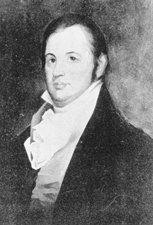John Pope (Kentucky politician)
John Pope | |
|---|---|
 | |
| United States Senator from Kentucky | |
| In office March 4, 1807 – March 3, 1813 | |
| Preceded by | Henry Clay |
| Succeeded by | Jesse Bledsoe |
| 12th Secretary of State of Kentucky | |
| In office October 21, 1816 – August 2, 1819 | |
| Governor | Gabriel Slaughter |
| Preceded by | Charles Stewart Todd |
| Succeeded by | Oliver G. Waggener |
| 3rd Governor of Arkansas Territory | |
| In office March 9, 1829 – March 9, 1835 | |
| President | Andrew Jackson |
| Preceded by | George Izard |
| Succeeded by | William S. Fulton |
| Member of the U.S. House of Representatives from Kentucky's 7th district | |
| In office March 4, 1837 – March 3, 1843 | |
| Preceded by | Benjamin Hardin |
| Succeeded by | William Thomasson |
| Member of the Kentucky Senate | |
| In office 1825-1829 | |
| Member of the Kentucky House of Representatives | |
| In office 1802 1806-1807 | |
| Personal details | |
| Born | February 1770 Prince William County, Virginia, British America |
| Died | July 12, 1845 (aged 75) Springfield, Kentucky, U.S. |
| Nationality | American |
| Political party | Democratic-Republican (as Senator) Democratic (as Governor) Whig (as Representative) |
| Occupation | Lawyer, politician |
John Pope (February 1770 – July 12, 1845)[1] was a United States Senator from Kentucky, a member of the United States House of Representatives from Kentucky, Secretary of State of Kentucky, and the third Governor of Arkansas Territory.
Early life and education
Pope was born in Prince William County, Virginia in 1770. He lost his arm during his youth and was known as "One-Arm Pope". He graduated from the College of William & Mary, studied law and moved to Springfield, Kentucky where he was admitted to the bar. He practiced law in Washington, Shelby, and Fayette County, Kentucky.
Political career
Pope served as the presidential elector from Kentucky in 1801, and was elected to the Kentucky House of Representatives in 1802. He served in the House again from 1806 to 1807.[2]
Pope was elected as a Jeffersonian Republican to the United States Senate, serving from 1807 to 1813, and served as President pro tempore of the Senate during the Eleventh Congress. Pope was Secretary of State of Kentucky from 1816 to 1819, under Governor Gabriel Slaughter.[3]
He served as a member of the Kentucky Senate from 1825 to 1829, and was also elected three times to the United States House of Representatives, initially as an Independent[4] and then as a Whig, serving Kentucky's District 7 between 1837 and 1843.
From 1829 to 1835, he served as the Governor of Arkansas Territory. During his term as governor he arranged for the construction of the Old State House which remains the oldest surviving state capitol west of the Mississippi River.
Death
John Pope died in Springfield, Kentucky, and is buried in the Springfield Cemetery.[5]
Personal life
Pope was married to the sister-in-law of President John Quincy Adams. He was also the brother of Nathaniel Pope, a prominent figure in early Illinois Territory, and the uncle to both John Pope, Union General in the Civil War and Daniel Pope Cook, another prominent politician in the early history of the state of Illinois.
Legacy
Pope County, Arkansas is named for him.[6]
See also
- Thomas S. Hinde, close friend and adviser.
References
- ^ encyclopediaofarkansas.net
- ^ "Pope, John (1770–1845)". Biographical Directory of the United States Congress. Retrieved August 9, 2012.
- ^ "Secretary of State John Pope". Kentucky Secretary of State. Retrieved August 10, 2012.
- ^ Dubin, Michael J. (March 1, 1998). United States Congressional Elections, 1788–1997: The Official Results of the Elections of the 1st Through 105th Congresses. McFarland and Company. p. 117. ISBN 978-0786402830.; Martis, Kenneth C. (January 1, 1989). The Historical Atlas of Political Parties in the United States Congress, 1789–1989. Macmillan Publishing Company. p. 94. ISBN 978-0029201701.; Moore, John L., ed. (1994). Congressional Quarterly's Guide to U.S. Elections (Third ed.). Congressional Quarterly Inc. p. 966. ISBN 978-0871879967.
- ^ "John "One-Arm Pope" Pope". Find A Grave. Retrieved August 9, 2012.
- ^ "Profile for Pope County, Arkansas, AR". ePodunk. Retrieved August 10, 2012.
Further reading
- Allen, William B. (1872). A History of Kentucky: Embracing Gleanings, Reminiscences, Antiquities, Natural Curiosities, Statistics, and Biographical Sketches of Pioneers, Soldiers, Jurists, Lawyers, Statesmen, Divines, Mechanics, Farmers, Merchants, and Other Leading Men, of All Occupations and Pursuits. Bradley & Gilbert. pp. 370–372. Retrieved 2008-11-10.
- Baylor, Orville W. (April 1941). "The Life and Times of John Pope -1770-1845". Filson Club History Quarterly. 15 (2). Retrieved 2011-11-30.
External links
- American politicians with physical disabilities
- Governors of Arkansas Territory
- Members of the United States House of Representatives from Kentucky
- Kentucky State Senators
- Members of the Kentucky House of Representatives
- 1770 births
- 1845 deaths
- People from Prince William County, Virginia
- United States Senators from Kentucky
- Secretaries of State of Kentucky
- College of William & Mary alumni
- Kentucky Whigs
- Kentucky Democratic-Republicans
- Kentucky Democrats
- Democratic-Republican Party United States Senators
- Arkansas Democrats
- Whig Party members of the United States House of Representatives
- 19th-century American politicians
- Presidents pro tempore of the United States Senate



